It’s one of the most common questions people ask me when working with me on sustainable weight loss and fitness – how many calories should I eat each day? The answer depends on your goal. Whether you’re trying to drop fat, build muscle, or stay the same, your daily calorie target will vary based on what you want to achieve, how active you are, how consistent you can be, and personal factors like your age, height and current weight.
In this blog, I’ll break it down in simple terms, so you know what to do whether your goal is fat loss, muscle gain, or just staying the same. You’ll also learn how to eat around your workouts and whether you really need to eat back the calories you burn.
What Is a Calorie?
Calories are just a way of measuring energy – the energy in food, and the energy your body uses to function. You burn calories just by being alive, but you’ll use more the more you move, exercise, or stay on your feet. The food and drink you consume give you calories, which your body uses to keep going, repair itself, and power everything from walking up the stairs to lifting weights at the gym.
Your Daily Calories Depend on Your Goal
There’s no one-size-fits-all answer to how many calories you should eat. It depends on things like your weight, age, height, and activity levels – but most of all, it depends on your goal. Do you want to lose weight, gain muscle, or maintain what you’ve got? Let’s look at each one:
How Many Calories to Lose Weight?
To lose weight, you need to eat fewer calories than your body uses – this is known as a calorie deficit. The size of that deficit plays a big role in how fast or slow you lose weight.
A common recommendation is to reduce your daily intake by around 300 to 500 calories per day below your maintenance level. This often results in a loss of 0.5 to 1kg per week, depending on your starting point. But rather than focusing on the exact number of calories, it’s better to think in terms of percentage of body weight.
A safe and sustainable rate of weight loss is around 0.5% to 1% of your body weight per week. So, if you weigh 80kg, this would mean aiming to lose 0.4 to 0.8kg per week. You can work backwards from that target to estimate the size of the calorie deficit you need – bearing in mind that roughly 7,700 calories equals 1kg of body fat.
Some people do go harder – running bigger deficits of 600 to 1,000 calories a day – and this might work short-term, especially for those with a lot of weight to lose. But extreme calorie deficits often backfire. You risk losing muscle, feeling low on energy, and struggling with hunger, which makes it harder to stick to the plan. Muscle loss can also be a risk with rapid weight loss in general, including for people using GLP-1 medications like Wegovy, Ozempic, or Saxenda. I’ve worked with clients using these medications, and we focus on increasing protein intake and strength training to help preserve as much muscle as possible during the process.
Use my calorie calculator to find out your maintenance level and get a realistic fat loss target based on your personal details.
Maintenance Calories: How to Stay the Same Weight
If you’re happy with your current body weight and just want to stay healthy, fuel your lifestyle, and maintain your strength and energy, then you’ll want to eat around your maintenance calories.
Your maintenance level is the number of calories your body uses in a day, including your workouts, movement, and general daily activity. If you eat roughly this amount over time, your weight will stay stable. You might go up or down by a pound here or there, but the overall trend will be level.
Eating at maintenance is also a good option if you’re in between goals, focusing on performance, or working on healthy habits like meal prepping or improving your nutrition without worrying about the scales.
Maintenance Calories and Exercise: Should You Eat Back What You Burn?
If you’re eating at maintenance and you exercise regularly, you’ll probably wonder whether to eat back the calories you burn. The answer isn’t always yes – but it’s not always no, either.
Let’s say your maintenance calories are 2,200. You go for a 45-minute cycle and your fitness tracker says you burned 400 calories. Should you now eat 2,600 calories? Not necessarily.
Most calorie calculators already factor in your activity level – especially if you’ve selected something like “moderately active” or “very active”. If that’s the case, your maintenance number already assumes you’re doing regular workouts.
But if you’ve logged your activity level as low or sedentary, and then you go and run 5k, it makes sense to eat a bit more that day. How much more depends on the intensity and length of the session, but you don’t need to match it exactly. A small post-run meal or snack might be enough to refuel and recover.
If you’re training for something specific – like cycling events, running races, or gym performance – it’s usually a good idea to eat back some of what you burn, especially if your goal isn’t fat loss. This helps support your performance and stops you from feeling drained or under-fuelled.
How Many Calories for Muscle Gain?
If your goal is to gain muscle, you’ll need to eat in a calorie surplus – that means consuming more calories than your body uses, so it has the extra energy to build new muscle tissue.
This doesn’t mean you need to eat loads of food or start “dirty bulking”. A small surplus of 100 to 300 calories a day is usually enough to support lean muscle growth without adding lots of unwanted body fat.
Your training also matters here – make sure you’re doing a progressive strength training plan and getting enough protein. Aim for at least 1.6g of protein per kg of body weight, and make strength training a priority at least three times a week.
Can You Gain Muscle in a Deficit or During Maintenance?
Yes – especially if you’re new to training or coming back after time off. In the early stages, your body is very responsive to strength training, and you can build muscle while eating at maintenance, or even in a small calorie deficit. This is sometimes called “recomping” – short for body recomposition.
Even for more experienced people, it’s possible to build some muscle at maintenance, particularly if you dial in your training, recovery, sleep, and nutrition. But over time, you’ll get better results with a slight surplus – just enough to fuel growth, not so much that you gain excess fat.
How To Work Out Your Calories
Now you’ve read this blog and you understand roughly how many calories you might need to lose weight, maintain it or support your training, you’re probably thinking, yes but what are my numbers?
I’ve got you covered. Just head over to my calorie calculator where you can work out your daily calorie needs. It’s quick and easy to use and it gives you personalised figures based on your lifestyle. Whether you do regular sport, have an active job or spend most of your day sitting at a desk, the calculator takes it all into account.
Visit the calorie calculator, pop in your details and you’ll get the numbers you need to start making informed choices.
Ready to Hit Your Goals?
If your goal is fat loss and you want expert guidance, personalised nutrition advice, and support every step of the way, check out my online weight loss coaching service – it’s helped hundreds of people lose weight without the guesswork.
Looking for a structured training plan, accountability, and someone to take care of the details? My online personal training service is perfect if you’re ready to train smarter and make progress.




